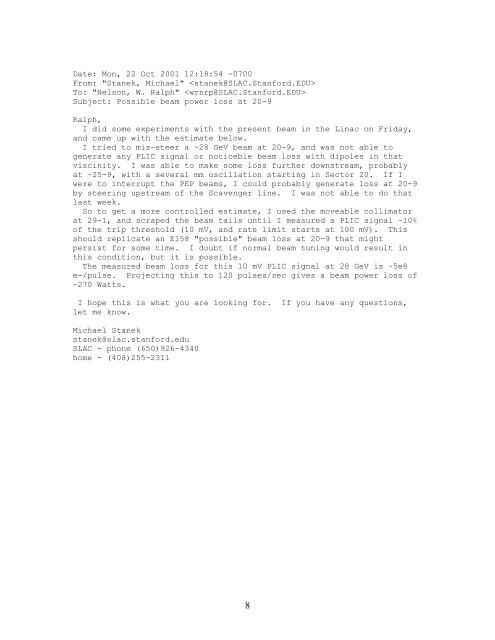You also want an ePaper? Increase the reach of your titles
YUMPU automatically turns print PDFs into web optimized ePapers that Google loves.
Date: Mon, 22 Oct 2001 12:18:54 -0700<br />
From: "Stanek, Michael" <br />
To: "Nelson, W. Ralph" <br />
Subject: Possible beam power loss at 20-9<br />
Ralph,<br />
I did some experiments with the present beam in the Linac on Friday,<br />
and came up with the estimate below.<br />
I tried to mis-steer a ~28 GeV beam at 20-9, and was not able to<br />
generate any PLIC signal or noticeble beam loss with dipoles in that<br />
viscinity. I was able to make some loss further downstream, probably<br />
at ~25-9, with a several mm oscillation starting in Sector 20. If I<br />
were to interrupt the PEP beams, I could probably generate loss at 20-9<br />
by steering upstream of the Scavenger line. I was not able to do that<br />
last week.<br />
So to get a more controlled estimate, I used the moveable collimator<br />
at 29-1, and scraped the beam tails until I measured a PLIC signal ~10%<br />
of the trip threshold (10 mV, and rate limit starts at 100 mV). This<br />
should replicate an E158 "possible" beam loss at 20-9 that might<br />
persist for some time. I doubt if normal beam tuning would result in<br />
this condition, but it is possible.<br />
The measured beam loss for this 10 mV PLIC signal at 28 GeV is ~5e8<br />
e-/pulse. Projecting this to 120 pulses/sec gives a beam power loss of<br />
~270 Watts.<br />
I hope this is what you are looking for. If you have any questions,<br />
let me know.<br />
Michael Stanek<br />
stanek@slac.stanford.edu<br />
SLAC - phone (650)926-4340<br />
home - (408)255-2311<br />
8











